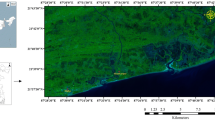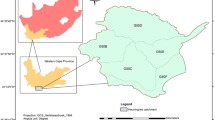Abstract
The objective of the present study was to assess the deterioration in groundwater quality due to saline water intrusion in the Ad-Darb region of southwestern Saudi Arabia. An integrated approach using geochemical and geophysical methods was applied to assess the extent of saline water intrusion. Geochemical methods involved the determination of main groundwater facies present in the region using Piper and extended Durov plots. The geophysical methods used in the study included seismic refraction (SR), seismic refraction tomography (SRT), vertical electrical soundings (VES), and electrical resistivity tomography (ERT). Two SR and SRT surveys, three ERT surveys, and nine VES surveys were carried out. Piper plot shows that the water mainly belongs to the SO4-Cl type of anionic facies. The Durov plot indicates base ion exchange, linear mixing, and saline water intrusion as the main factors influencing the groundwater chemistry of the area. The TDS increases towards the coast, with values reaching as high as 9000 mg/l. These results confirm the interpretation of the vertical electrical sounding (VES) and electrical resistivity tomography (ERT) sections which indicates the presence of saline water intrusion, with the thickness of the intruded zone increasing towards the sea. The geoelectric resistivity results indicate four geoelectric resistivity layers. The average thickness of upper layer is 2.5 m and the resistivity ranges from 22.5 to 280 Ωm. The P wave velocity of this layer varies from 488 to 787 m/s. The second geoelectric resistivity zone consists of relatively disconnected layers with 10 to 33 m thickness and 52 to 120 Ωm resistivity. The third zone is a low resistivity zone, increasing in thickness westwards towards the sea and with resistivities of 0.3 to 19.5 Ωm. This is the main zone (consisting of unconsolidated Quaternary sediments) affected by saline water intrusion. This zone is intercalated with muddy marine intercalations, as indicated by its low resistivity (as low as 0.3 Ωm) The second and third geoelectric resistivity layer is represented by a single seismic zone with P wave seismic velocities ranging from 1231 to 1524 m/s, indicating the presence of water. The resistivity of the lowest layer ranges from 56 to 822 Ωm and corresponds to the basement. This bedrock layer has seismic velocities varying between 2315 and 3164 m/s.












Similar content being viewed by others
References
Abarca E, Vázquez-Suñé E, Carrera J, Capino B, Gámez D, Batlle F (2006) Optimal design of measures to correct seawater intrusion. Water Resour Res 42(9)
Abdalla F (2016) Ionic ratios as tracers to assess seawater intrusion and to identify salinity sources in Jazan coastal aquifer, Saudi Arabia. A J Geosci 9(40). https://doi.org/10.1007/s12517-015-2065-3
Abou Auf M, Elshater A (1992) Sedimentology and mineralogy of Jizan shelf sediments Red Sea, Saudi Arabia. J KAU Mar Sci 3:39–54
Albassam AM, Hussein MT (2008) Combined geo-electrical and hydro-chemical methods to detect salt-water intrusion. Manag Environ Qual 19(2):179–193
Albassam AM, Khalil AR (2012) DurovPwin: A new version to plot the expanded Durov diagram for hydro-chemical data analysis. Comput Geosci 42:1–6
Albassam AM, Awad HS, Al-Alawi JA (1997) Durov plot: a computer program for processing and plotting hydrochemical data. Groundwater 35(2):362–367
Andersen PF, Mercer JW, White HO (1988) Numerical modeling of salt-water intrusion at Hallandale, Florida. Groundwater 26(5):619–630
Arshad M, Cheema JM, Ahmed S (2007) Determination of lithology and groundwater quality using electrical resistivity survey. Int J Agric Biol 9:143–146
Asfahani J (2006) Geoelectrical investigation for characterizing the hydrogeological conditions in semi-arid region in Khanasser valley, Syria. J Arid Environ 68:31–52
Batayneh A, Elawadi E, Mogren S, Ibrahim E, Qaisy S (2012) Groundwater quality of the shallow alluvial aquifer of Wadi Jazan (southwest Saudi Arabia) and its suitability for domestic and irrigation purpose. Sci Res Essays 7(3):352–364
Bauer P, Supper R, Zimmermann S, Kinzelbach W (2006) Geoelectrical imaging of groundwater salinization in the Okavango Delta, Botswana. J Appl Geophys 60(2):126–114
Bello AA, Makinde V (2007) Delineation of the aquifer in the Southwestern part of the Nupe Basin, Kwara State. Nigeria J Am Sci 3:36–44
Benkabbour B, Toto EA (2004) Fakir Y (2004) Using DC resistivity method to characterize the geometry and the salinity of the Plioquaternary consolidated coastal aquifer of the Mamora plain. Morocco Environ Geol 45:518–526
Brookes M, Kearey P (1988) An introduction to geophysical exploration. English Language Book society/ Blackwell Scientific Publication, P. 296.
Choudhury K, Saha DK, Chakraborty P (2001) Geophysical study for saline water intrusion in a coastal alluvial terrain. J Appl Geophys 46:189–200
El Alfy M, Lashin A, Al-Arifi N, Al-Bassam A (2015) Groundwater characteristics and pollution assessment using integrated hydrochemical investigations GIS and multivariate geostatistical techniques in arid areas. Water Resour Manag 29(15):5593–5612
Elawadi E, Mogren S, Ibrahim E, Batayneh A, Albassam A (2012) Utilizing potential field data to support delineation of groundwater aquifers in the southern Red Sea coast, Saudi Arabia. J Geophys Eng 9(3):327–335
Freeze RA, Cherry J A (1979) Groundwater, 604 pp.
Frohlich RK, Urish DW, Fuller J, Reilly MO (1994) Use of geoelectrical method in groundwater pollution surveys in a coastal environment. J Appl Geophys 32:139–154
Hamdan H, Candansayar E, Demirci I, Economou N, Andronikidis N, Arslan H, Soupios P, Vafidis A (2015) Imaging the saline/fresh water interface at Bafra, Turkey using joint inversion of seismic refraction and ERT data. Eighth Congress of the Balkan Geophysical Society, 05 October 2015, DOI. https://doi.org/10.3997/2214-4609.201414146
Khalil MA, Monterio FAS (2009) Influence of degree of saturation in the electric resistivity-hydraulic conductivity relationship. Surv Geophys, 2009;https://doi.org/10.1007/s10712-009-9072-4
Lloyd JW, Heathcote JAA (1985) Natural inorganic hydrochemistry in relation to groundwater. Clarendon Press, Oxford
Mogren S (2015) Saltwater intrusion in Jizan coastal zone, southwest Saudi Arabia. Inferred from geoelectric resistivity survey. Int J Geosci 2(6):286–297
MoWE (2014) National water strategy, Kingdom of Saudi Arabia. Unpublished Report.
MoWE (2015) Detailed water resources assessment of western coastal plain of Saudi Arabia. Unpublished report
Omosuyi GO, Adeyemo A, Adegoke AO (2007) Investigation of groundwater prospect using electromagnetic and geoelectric sounding at Afunbiowo, near Akure. Niger Pac J Sci Technol 8:172–182
Piper AM (1944) A graphic procedure in geochemical interpretation of water analyses. Trans Am Geophys Union 25:914–923
Samsudin AR, Haryono A, Hamzah U, Rafek AG (2007) Salinity mapping of coastal groundwater aquifers using hydro geochemical and geophysical methods: a case study from north Kelantan, Malaysia. Environ Geol 55(8):1737–1743
Satriani A, Loperte A, Imbrenda V, Lapenna V (2012) Geoelectrical surveys for characterization of the coastal saltwater intrusion in Metapontum Forest Reserve (Southern Italy). Int J Geophys 238478:8. https://doi.org/10.1155/2012/238478
Sherif M, El Mahmoudi A, Garamoon H, Kacimov A (2006) Geoelectrical and hydrogeochemical studies for delineating seawater intrusion in the outlet of Wadi Ham, UAE. Environ Geol 49(4):536–555
Spalding RF, Exner ME (1993) Occurrence of nitrate in groundwater-a review. J Environ Qual 22(3):392–402
Stampolidis A, Tsourlos P, Soupios P, Th M, Tsokas GN, Vargemezis G, Vafidis A (2005) Integrated geophysical investigation around the brackish spring of Rina, kalimnos Isl., SW Greece. J Balkan Geophys Soc 8(3):63–73
Stefani JP (1995) Turning-ray tomography. Geophysics 60:1917–1929
Sumanovac F, Weisser M (2001) Evaluation of resistivity and seismic methods for hydrogeological mapping in karst terrains. J Appl Geophys 47:13–28
Sung-Ho S, Jin-Yong L (2007) Namsik P (2007) Use of vertical electrical soundings to delineate seawater intrusion in a coastal area of Byunsan. Korea Environ Geol 52:1207–1219
Urish DW, Frohlich RK (1990) Surface electrical resistivity in coastal groundwater exploration. Geoexploration 26(4):267–289
Vafidis A, Soupios P, Economou N, Hamdan Andronikidis HN, Kritikakis G, Panagopoulos G, Manoutsoglou E, Steiakakis M, Candansayar E, Schafmeister M (2014) Seawater intrusion imaging at Tybaki, Crete, using geophysical data and joint inversion of electrical and seismic data. Near Surf Geosci 32:107–114
White DJ (2007) Two-Dimensional seismic refraction tomography. Geophys J Int 97(2):223–245
WHO (2011) Guidelines for drinking-water quality, fourth edition. ISBN: 9789241548151. pp. 564
Zaidi FK, Al-Bassam AM, Kassem OM, Alfaifi HJ, Alhumidan SM (2017) Factors influencing the major ion chemistry in the Tihama coastal plain of southern Saudi Arabia: evidences from hydrochemical facies analyses and ionic relationships. Environ Earth Sci 76(14):472
Zghibi A, Mezougui A, Zouhri L, Tarhouni J (2014) Understanding groundwater chemistry using multivariate statistics techniques to the study of contamination in the Korba unconfined aquifer system of Cap-Bon (North-east of Tunisia). J Afr Earth Sci 89:1–15
Zhu X, McMechan GA (1989) Estimation of two-dimensional seismic compressional wave velocity distribution by interactive tomographic imaging. Int J Image Sys Technol 1:13–17
Zohdy A, Eaton G, Mabey D (1974) Application of surface geophysics to groundwater investigations. U.S.G.S., Book 2, Chapter D.
Funding
This study was financially supported by the Deanship of Scientific Research at King Saud University through research group no RGP-1437-041.
Author information
Authors and Affiliations
Corresponding author
Additional information
Editorial handling: Mansour A. Al-Garni
Rights and permissions
About this article
Cite this article
Alfaifi, H., Kahal, A., Albassam, A. et al. Integrated geophysical and hydrochemical investigations for seawater intrusion: a case study in southwestern Saudi Arabia. Arab J Geosci 12, 372 (2019). https://doi.org/10.1007/s12517-019-4540-8
Received:
Accepted:
Published:
DOI: https://doi.org/10.1007/s12517-019-4540-8




